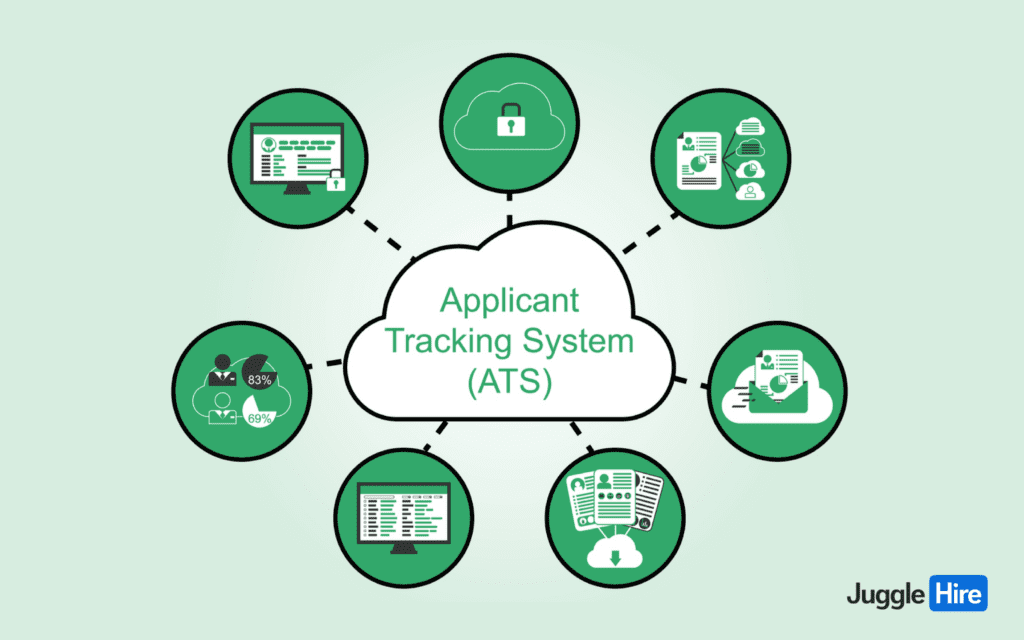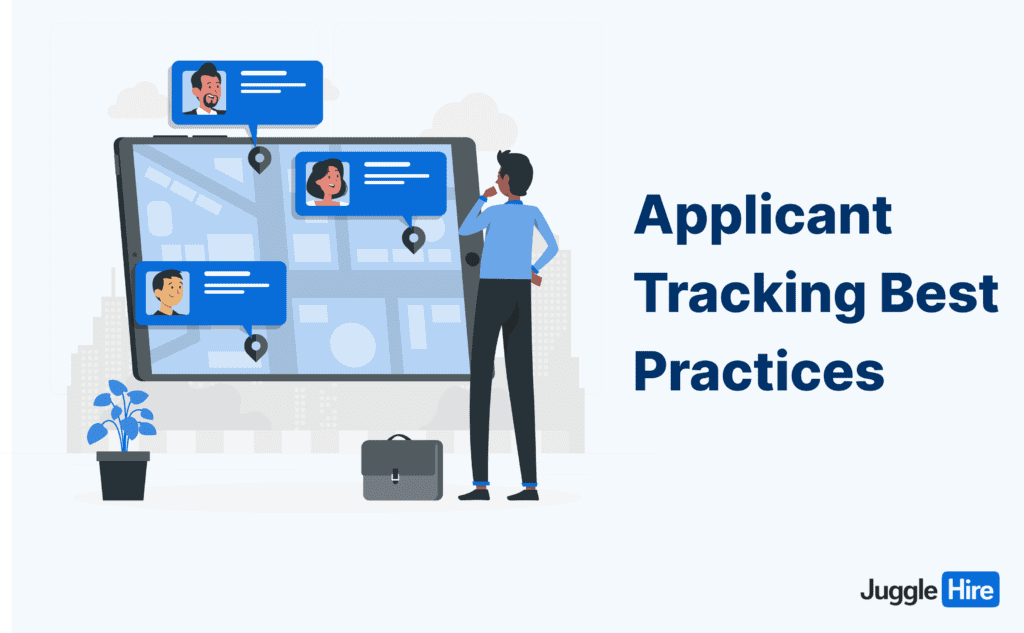Applicant Tracking System Best Practices: 12 Tips for Small Businesses
Recruitment is an important part of any organization. And in today’s fast-paced world, finding the right talent efficiently is more important than ever. This is where an Applicant Tracking System (ATS) comes in handy. An ATS is a powerful tool that helps companies organize and streamline their hiring process.
Today about 98.8% of Fortune 500 companies use applicant tracking systems (ATS).
However, like any tool, an ATS can be both incredibly helpful and challenging, depending on how it’s used. But it is not just about automating the recruitment process. It is about using it efficiently. It is about embracing the applicant tracking system best practices.
This way, you’ll be able to avoid common pitfalls that can lead to missed opportunities and a negative candidate experience.
Our aim with this guide is to provide you with practical tips and insights on how to optimize your ATS usage. So, let’s dive in and learn how to use your ATS to its full potential.
Basic Things About an Applicant Tracking System

Applicant Tracking System (ATS) is a software used by companies to manage job applications. Understanding how these systems work is crucial for job seekers. ATS makes the hiring process more efficient for employers but requires applicants to be strategic in how they present their qualifications.
What is an Applicant Tracking System
An Applicant Tracking System (ATS) is a specialized software used by companies to manage their recruitment process. It is designed to help organizations streamline the complex task of hiring new employees. An ATS usually serves multiple functions.
For example, it collects and organizes applicant data, filters applicants based on predetermined criteria, ranks candidates, and assists in scheduling interviews. Also, it acts as a bridge between potential employees and the company. It ensures that the recruitment process is smooth, efficient, and fair.
Related: What is An Applicant Tracking System- A Comprehensive Guide for Beginners
How an Applicant Tracking System Works
Understanding how an ATS works is important for both recruiters and job seekers to ensure applicant tracking system best practices. The system is designed to sort through applications quickly to differentiate which candidates best match the job criteria.
It starts when a job seeker submits their application through the system. The Applicant Tracking System Software then parses the information from the resume and application form into a standardized format. This is a crucial step because it allows the system to analyze the information accurately.
Once the data is parsed, the ATS begins the process of filtering and ranking candidates. It does this based on algorithms and keywords specified by the hiring team. For example, if the job requires specific skills or qualifications, the ATS will look for those terms in each application.
Those that match closely will rank higher and move forward in the process. This ensures that recruiters focus their attention on candidates who are the most qualified.
The ATS also facilitates other parts of the hiring process. It can be used to post job openings to multiple job boards and social media platforms, schedule interviews, and even assist in performing background checks.
Additionally, it collects data throughout the hiring process. This data can be analyzed to improve future recruitment strategies. It might include metrics like the time to fill a position, the effectiveness of different job boards, and the diversity of applicants.
So, an ATS automates many of the time-consuming tasks involved in recruitment. By doing so, it not only speeds up the hiring process but also helps ensure that it’s fair and unbiased. However, it’s important for both recruiters and job seekers to understand that an ATS is just a tool.
Granted that it can screen and rank candidates based on specific criteria, but the final hiring decision always rests with the human recruiters. Because they bring their judgment and experience to the process.
Common Features of an Applicant Tracking System
Most ATS offers a range of features designed to optimize recruitment:
- Resume Parsing and Ranking: ATS converts unstructured resume data into a structured form. Thus, it ranks candidates based on job relevance.
- Job Posting: It distributes job openings to multiple job boards and also on social media platforms.
- Candidate Communication: It facilitates automated emails and notifications to candidates. It lets them know about their application status.
- Interview Scheduling: ATS coordinates dates and times between candidates and interviewers.
- Compliance Management: It also ensures hiring practices comply with labor laws and regulations.
What Are the Benefits of an Applicant Tracking System in Recruitment?

When you’re recruiting, the benefits of the Applicant Tracking System are numerous. These benefits help streamline the hiring process. Let’s explore these benefits in detail:
1. Efficient Candidate Screening
The efficiency in candidate screening is one the most significant advantages of ATS. An ATS can automatically review resumes and applications, quickly identifying candidates who meet specific job requirements.
This saves you a lot of time, as you don’t have to manually read through every application. The system can screen for keywords, skills, experience, and more. It ensures that only the most relevant applicants are considered.
2. Reduced Administrative Work
With an ATS, a lot of the administrative burden is lifted from the recruitment team. The system can handle tasks like scheduling interviews, sending out automated emails to candidates, and organizing candidate information.
This reduction in paperwork and manual tasks allows you as a recruiter to focus more on engaging with candidates. This also facilitates them to make more strategic decisions.
3. Improved Candidate Quality
Since an ATS can efficiently screen for the most qualified candidates, the overall quality of applicants moving through the hiring process is higher. You can set the system to look for candidates who not only have the right skills and experience but also fit the company culture.
4. Enhanced Collaboration
An ATS allows for better collaboration among hiring teams. Team members can easily share candidate profiles, leave notes, and make recommendations within the system. This ensures everyone involved in the hiring process is on the same page and can contribute effectively.
5. Data-Driven Decision-Making
ATS systems can provide valuable data and insights into the recruitment process. You can see which sourcing channels bring in the best candidates, how long it takes to fill a position, and other metrics.
This information helps in making informed decisions. It also improves their future recruitment strategies.
6. Compliance and Reporting
Staying compliant with employment laws and regulations is also very important. An ATS helps in maintaining compliance by storing candidate data securely and managing it according to legal requirements.
Applicant tracking system compliance also makes reporting easier. As it can generate reports on various aspects of the recruitment process.
7. Streamlined Communication
Communication with candidates is more streamlined with an ATS. The system can send automated emails for acknowledgments, updates, and feedback.
This ensures candidates are kept in the loop throughout the recruitment process, be it an applicant tracking software for small businesses or large ones. It improves the candidate experience and the employer’s brand.
Applicant Tracking System Best Practices- 12 Tips for Beginners

In this section, we will discuss applicant tracking system best practices in detail. As someone involved in the recruitment process, it will surely help you in your hiring journey.
1. Clear and Concise Job Descriptions
It’s important to write job descriptions that are easy to understand and specific. Clearly mention the job duties and the qualifications and skills you’re looking for.
For example, if you are looking for a ‘Senior Web Developer,’ say exactly what you need. You might write, “Need someone with 5 years of experience in JavaScript and PHP. They should have made websites for online stores.”
This way, the ATS can find the right people who really fit what you’re looking for.
2. Customized ATS Filters
Always set up the ATS to look for specific things and it will help find the best people for each job. Say you need someone for a sales job. You can set the ATS to look for resumes that say “experience in B2B sales” or “has met sales goals before.”
This helps the ATS pick out resumes that really match what you need. It’s also important to change these settings if the job changes. This makes sure you always find the right people.
For example, if you start looking for someone who also needs to be good at giving presentations, you can add that to the ATS settings.
3. Keywords Optimization
Using the right keywords in your job post helps the ATS find the best candidates. This is another significant part to ensure applicant tracking system best practices. For a job in digital marketing, include words like “SEO,” “certified in Google Analytics,” and “has used Facebook Ads.”
This makes it easier for the ATS to find people who have these specific skills. It’s like telling the ATS exactly what to look for. This way, you get resumes from people who really know how to do the job.
Be clear about the skills and experience you need. This helps the ATS work better and gets you better candidates.
4. Acronym Clarity
When you use short forms or special words in your job post, make sure they are clear. Not all ATS systems and applicants understand the same short forms.
For example, if you write “CRM” in a job post, also mention “Customer Relationship Management” at least in the job description. This helps both the ATS and the people applying to understand better.
If you’re hiring for a technical job and use a lot of special words or acronyms, explain them so there’s no confusion. This makes sure the ATS picks the right resumes and people understand the job well.
5. Timely and Constructive Feedback
When people apply for a job, it’s good to use the ATS to give them feedback quickly. If someone doesn’t get the job, you can send an email from the ATS. Tell them why they didn’t get it and encourage them to try again later.
This is good because people feel better when they know why they didn’t get chosen. They might be right for another job in the future. Using the ATS this way also makes people think well of your company. It’s important to be nice and helpful in your messages.
6. Data Privacy Compliance
Data Privacy Compliance is another one of applicant tracking system best practices. When using an ATS, you have to be careful with people’s personal information. Make sure the ATS follows laws about keeping information safe. For example, in Europe, there’s a law called GDPR. It says you have to ask people if it’s okay to keep their information and let them see or remove it if they want.
It keeps people’s information safe and makes sure you’re following the law.
7. Length of Job Descriptions
The length of your job descriptions should balance detail with conciseness. Ideally, you should aim for about 300-700 words. This length is enough to cover essential details like job responsibilities, required qualifications, and company culture without overwhelming the applicant.
For example, include a detailed section on job responsibilities that clearly outlines daily tasks and expectations. Another section on qualifications should list the necessary education, skills, and experience.
You can also include a brief introduction about the company and its values. It can help attract candidates who align with the company’s culture.
8. Leveraging ATS Analytics
Utilizing ATS analytics can significantly improve the recruitment process which is another best practice for applicant tracking system. These analytics give insights like the source of the best candidates, the time taken to fill a position and the stages where most candidates drop out.
For example, if analytics show that most high-quality candidates are coming from a particular job board, you can focus more on that platform for future postings. Regular analysis of these metrics helps in fine-tuning recruitment strategies for better outcomes.
9. Simplified Application Process
A simplified application process is important for a positive candidate experience. Ensure that the application can be completed in a reasonable time, preferably within 15-20 minutes.
Avoid asking for redundant information or making candidates navigate through multiple pages. For example, having a one-page application form with essential fields like personal details, resume upload, and key qualifications can make the process simple.
10. Formatting Consistency
Consistency in formatting job postings is important for an ATS to effectively parse and categorize information. Try to use a standard template for all job postings, which includes clearly defined sections for job titles, responsibilities, qualifications, and company information.
Use headings, bullet points, and spacing consistently. It makes it easier for the ATS to scan and extract relevant information.
11. Regularly Update Job Postings
Regularly updating job postings ensures that the information remains accurate and relevant. If a role’s requirements change or if the position is filled, the job posting should reflect this immediately.
For example, if a role initially required two years of experience but the requirements have changed to three years, update this in the posting to attract the right candidates.
12. Collaboration Among Hiring Team Members
Effective collaboration among hiring team members is crucial for a smooth recruitment process. An ATS can facilitate this by allowing team members to share notes, feedback, and evaluations on candidates within the system.
This collaboration ensures a unified approach to hiring decisions. It also helps in selecting the best candidate for the role. For example, during the interview process, each interviewer can input their observations into the ATS. It can then be reviewed collectively by the hiring team before making a final decision.
Common Mistakes to Avoid in Applicant Tracking System Usage

When using an Applicant Tracking System (ATS) in the recruitment process, there are common mistakes that one should be aware of. It is to ensure they make the most out of their ATS. Avoiding these mistakes can significantly enhance the effectiveness of the hiring process.
I) Overcomplicating Job Descriptions
Writing job descriptions that are too complex or filled with industry jargon can be a big misstep. Such descriptions might confuse potential applicants. It may also affect how well the ATS identifies suitable candidates.
For example, if you’re hiring a graphic designer, list specific skills like proficiency in Adobe Creative Suite, rather than vague terms like ‘creative wizard’. This clarity helps the ATS in screening candidates accurately and attracts applicants who are truly fit for the role.
II) Neglecting to Customize Filters
Not customizing the ATS filters for each job opening is another common mistake. Each role has unique requirements and needs specific screening criteria. If the filters are too generic, the system might overlook qualified candidates or select unsuitable ones.
Customization ensures that the ATS works efficiently, working as an applicant screening software and screening candidates based on the most relevant criteria for each position.
III) Failing to Review Application Details
Relying solely on the ATS to evaluate candidates without human oversight can lead to missed opportunities. Because while an ATS can significantly streamline the recruitment process, it cannot entirely replace human judgment and intuition.
Sometimes, the system may screen out potentially good candidates. And it can be due to factors like unconventional resume formats or non-traditional career paths.
So, it is important to periodically review the application details. This way you can ensure that good candidates are not being inadvertently overlooked.
This can be especially important for roles where cultural fit and potential are as important as technical skills. A manual review of applications, even if it’s just a random sample, can provide a check on the ATS’s effectiveness.
IV) Not Updating Profiles Regularly
Failure to update the ATS profiles and job descriptions regularly can result in attracting the wrong candidates. As job roles evolve over time and company needs change, it’s important to keep the information in the ATS up to date.
This includes updating job descriptions, candidate requirements, and company information. Regular updates make sure that the ATS aligns with the current needs of the company. It attracts candidates who are a good fit for the evolving roles.
For example, if a role now requires experience in a new technology or software, you need to update the job description to reflect this is crucial.
V) Ignoring Candidate Feedback
Neglecting the feedback from candidates can bring a negative impact to the recruitment process. Candidate feedback can offer valuable insights into how user-friendly and effective the ATS is from an applicant’s perspective.
For example, if candidates frequently mention that the application process is too lengthy or confusing, it would be wise to simplify the process.
You should actively seek and incorporate feedback. It will ensure continuous improvement in the recruitment process and improve the candidate experience.
V) Data Privacy Compliance Neglect
Not complying to data privacy laws and regulations in the use of ATS can lead to serious legal consequences. It can damage the company’s reputation.
An ATS stores a significant amount of personal data from candidates. So, it is crucial to handle this data responsibly. Compliance involves ensuring that candidate data is securely stored, used, and managed in line with laws.
You should regularly review and update their data privacy policies, and ensure that their ATS provider is compliant as well. For example, candidates should be informed about what data is being collected, how it will be used, and how long it will be stored.
Regular training for HR staff on data privacy best practices is also essential. Ignoring this can lead to data breaches and legal issues. It can be costly and damaging to the company’s image.
Also Read: The Importance of Company Culture: 8 Reasons Why You Need It (and How to Build One)
Applicant Tracking System Best Practices- Key Takeaways for You
In conclusion, using an Applicant Tracking System (ATS) in your recruitment process can be a huge advantage. But it’s important to use it the right way. Remember to follow the tips provided in our guide of applicant tracking system best practices.
Keep job descriptions clear and simple, customize the ATS filters for each job, and don’t forget the human touch in your recruitment process.
Regular updates and attention to candidate experience are also key to making the most of your ATS. Ultimately, an ATS is a powerful tool. But it works best when you combine it with thoughtful strategies and a personal approach to finding the right talent.

Your point of view caught my eye and was very interesting. Thanks. I have a question for you.
Thanks. Feel free to ask, I’d be happy to help.
Thanks for sharing. I read many of your blog posts, cool, your blog is very good.